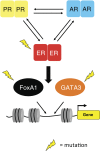Mechanisms of oestrogen receptor (ER) gene regulation in breast cancer
- PMID: 26884552
- PMCID: PMC5065078
- DOI: 10.1530/EJE-16-0124
Mechanisms of oestrogen receptor (ER) gene regulation in breast cancer
Abstract
Most breast cancers are driven by a transcription factor called oestrogen receptor (ER). Understanding the mechanisms of ER activity in breast cancer has been a major research interest and recent genomic advances have revealed extraordinary insights into how ER mediates gene transcription and what occurs during endocrine resistance. This review discusses our current understanding on ER activity, with an emphasis on several evolving, but important areas of ER biology.
© 2016 The authors.
Figures

References
-
- Fisher B, Costantino JP, Wickerham DL, Cecchini RS, Cronin WM, Robidoux A, Bevers TB, Kavanah MT, Atkins JN, Margolese RG, et al. Tamoxifen for the prevention of breast cancer: current status of the National Surgical Adjuvant Breast and Bowel Project P-1 study. Journal of the National Cancer Institute 2005. 97 1652–1662. 10.1093/jnci/dji372 - DOI - PubMed
Publication types
MeSH terms
Substances
Grants and funding
LinkOut - more resources
Full Text Sources
Other Literature Sources
Medical

